 |
|
|

0700 hours
Current Position: Anchored off the Pallisades
Day Two of the first leg of our Voyage of Discovery.
As the Half Moon sits at anchor just north of the George Washington Bridge, the student arise for their first full day of life on board the ship. Our first night of anchor watch passed uneventfully.
|

0730 hours
The captain starts our day by reading a few passages from Robert Juet's journal. Since the students will begin work on their scientific presentation projects today, captain Reynolds focuses on entries where Juet records the 1609 crew's observations of the river, particularly weather patterns and depth soundings. Our student crew will spend their time on board making similar observations, but with the advantage of modern scientific procedures and instrumentation.
|

0800 hours
Immediately after reading from Juet's journal, we dig into breakfast, which includes cereals and various fresh rolls and bisquits.
|

0830 hours
After breakfast, we call for a deck wash, using canvas buckets to collect river water.
|
0845 hours
 
With that done, Mr. Colley introduces the Matrix. Each day, we'll use the Matrix to record what activities each student has completed. Who's been on lookout or the helm? Who's climbed aloft? Who's taken a sounding? By the end of the voyage, our young sailors will have filled the Matrix with markers of their achievements.
|

0900 hours
We're in no rush to get moving today, so we introduce the students to the concept of lines of position.
|
  

The students take turns using a directional compass to sight the bearing of nearby prominent landmarks -- in this case, the little red lighthouse at the foot of the eastern supension tower of the George Washington Bridge. By finding three such landmarks on a chart and marking the relative direction to each, we can triangulate our own position on the river. Of course, this navigation technique can work on land as well!
|

After everyone has taken their readings, we compare our findings.
|
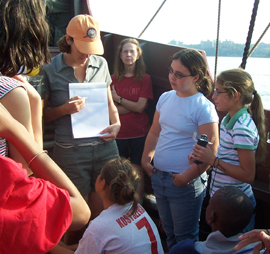 |
Mouse over to graph our results. |
The students have returned with some slight variations in their bearings, so we graph the results and discuss how those variations could arise, including the possibilities of instrument error or operator error. We also discuss various ways of determining which of our readings is likely to be the most accurate: should we use the average mode or the mean?
|
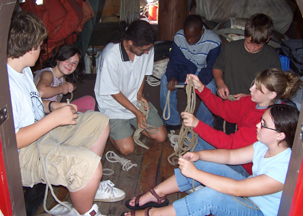 |
Mouse over to see new knot skills being put to use. |
0930 hours
As we continue our focus on shipcraft, the Colleys gather up more students for introductory knot lessons. The students are now reaching the point where they can help us rig tarps over the deck to shield us from the sun.
|

1000 hours
The students also take their first steps toward climbing aloft. Every student is trained in the use of a safety harness and learns safe climbing techniques -- primarily, the importance of maintaining three points of contact at all times.
Once the students are trained in safety, they climb into the rig to take their hang tests. Everyone passes with flying colors, so in the coming days they'll all be cleared to help work in the rig.
|

1145 hours
The time has come to weigh anchor and continue south. Weighing anchor is a complex process that incorporates the entire crew.
First, the below decks team rummages all of the gear on the orlop deck, moving it out of the way of the anchor rode, which they wrap around the lower capstan.
|
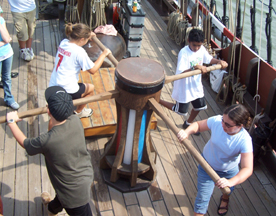 |
Mouse over to watch students walk the capstan. |
Once everything is in place below decks, the the students on the weatherdeck team insert bars in the upper capstan and walk the rode. The capstan is a massive winch that provides mechanical advantage in part by combining the strength of every crew member using it. As the capstan turns, it pulls the rode back into the ship.
|
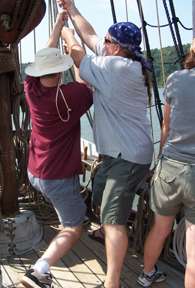 |
Mouse over to hoist the anchor. |
Once the anchor clears the water, the capstan team has done all it can. Up on the fore deck, Mr. Beiter and Mr. Prime use a pulley system -- another simple machine providing mechanical advantage -- to manually haul the anchor the rest of the way up. These pulleys allow just two crew members to lift an anchor and chain weighing hundreds of pounds.
|

Once the anchor is back on the channel, Mr. Dawson secures it and reinserts the "carrot" -- a tapered wooden rod that acts of a quick-release trigger.
With that, the anchor is ready for use again and we're on our way.
|

1215 hours
We pass under the George Washington Bridge and start passing along the skyline of Manhattan. We have a southerly wind belowing against us -- the humidity we're feeling is the result of a brewing storm far south of us -- so we'll be motoring today.
|

1230 hours
Mr. Prime gathers the students on the orlop deck to oversee how the morning went and organize their gear.
|

1300 hours
Lunch is served on the weather deck. Today we have a selection of wraps and sandwiches, as well as macaroni salad and veggies.
|

1330 hours
River traffic becomes congested as we pass southern Manhattan. Crew members gather along the starboard rail to see why all passing vessels have been channeled into the eastern side of the river...
|
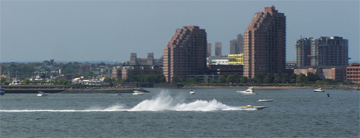 |
Mouse over for a closer look. |
It's a motorboat race! Various river patrol boats ensure that no vessels endanger themselves by getting too close.
|
 
We (and the rest of the river traffic) are redirected through the channel separating Manhattan from Governor's Island. With so many watercraft passing through this narrow space, both our Quarterdeck crew and our lookout Charly must keep alert at all times.
|

1400 hours
We enter New York Harbor and set anchor at our usual haunt, the Bay Ridge Flats. We'll remain here for the rest of the day.
|

1430 hours
With the ship at anchor, the students can now turn their attention to their academic projects. Our educators gathers all students on the weather deck and introduce them to the environmental phenomena and equipment they'll be focusing on for the rest of the voyage. This marks the first step of the team presentations they'll deliver on the 12th.
|
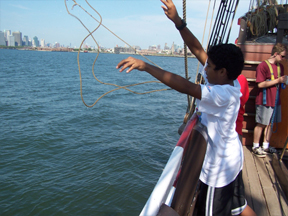 |
Mouse over to collect a water sample. |
Aaron tosses out a canvas bucket to collect our first water samples.
|

Once he and Fatima have the water sample on board, they take it back to the rest of their team, who use it to learn their way around our water science equipment.
|

The students also learn how to use a quadrant -- an instrument vital in Hudson's day and just as useful in ours.
While Jaquell uses a quadrant to measure the altitude of the sun (and, thus, could determine our own latitude), Karyn records her findings in her student journal.
|

The students gather in their respective presentation teams -- the Port and Starboard Watches -- to take turns learning about our instruments. While Starboard Watch is on the channel taking soundings and using the Secchi disk to measure clarity...
|

...Port Watch is near at hand, using anemometers to measure wind speed and sling psychrometers to measure humidity.
Once everyone in each team has used every instrument, the teams switch places to cover all areas of study.
|

1700 hours
As the afternoon winds down, we discover Ms. Wegman employing her cook's perogative ("What the cook wants to do, the cook gets to do") to spend some time aloft, photographing the harbor and reminiscing about her Voyafe of Discovery as a student crew member.
|
 
1845 hours
However, a cook's work is never done, so she soon returns below decks to serve dinner. Tonight we're feasting on two different pasta dishes and salad.
|

1900 hours
With the sun sinking to the west, the skies grow overcast -- and, in fact, while familiarizing themselves with the weather science instruments, students using the barometer noted a marked drop in air pressure. We've been monitoring the weather reports about the storm working its way toward us, and the most recent update is that we have about a 40% chance of rain tonight.
|

We take precautions well in advance of any storm's arrival. We lower our flags to protect them from the weather, and stretch tarps over the weatherdeck to help keep us dry.
We had also been considering staying here in New York Harbor for our 24-hour data collection layover, but with inclement weather coming we elect to move inland tomorrow instead.
Once the tarps are up, and before the sun sets, Captain Reynolds calls for an anchor watch briefing on deck. With that taken care of, we settle into our evening.
|

1930 hours
Of course, the day's not over just yet. Down in the galley, Ms. Wegman puts her assistants to good use: Fatima washes dishes while Charly cleans the table.
|

2100 hours
The orientation phase of the students' presentations is drawing to a close. Mr. Beiter calls for a meeting on the orlop deck, where he and the students discuss how to form a testable hypothesis. By the end of the briefing, each student has chosen a specific topic to study within their module and has prepared a theory to test. Tomorrow we'll start collecting data.
|

2200 hours
Lights out! Our weary crew members retire to their bunks and bedrolls. Anchor watch passes quietly, though we do get a little rain in the wee hours of the morning.
|
| |
On this date in 1609:
The ninth, faire weather. In the morning, two great Canoes came aboord full of men; the one with their Bowes and Arrowes, and the other in shew of buying of knives to betray us; but we perceived their intent. Wee tooke two of them to have kept them, and put red Coates on them, and would not suffer the other to come neere us. So they went on Land, and two other came aboord in a Canoe: wee tooke the one and let the other goe; but hee which wee had taken got up and leapt over-boord. Then we weighed and went off into the channell of the River, and Anchored there all night.
-- Robert Juet's Journal.
|
| |
|
|
|










































